With the question of safety. The question is can you microwave dog food? Has arrived. It is very crucial for the owners. It is not only applicable for the safety but also for the overall well-being of your puppy.
Dogs are beloved members of our families and their health is a top priority. Therefore, it is crucial to know whether microwaving their food can harm them in any way.
This simple act can have significant implications for your pet’s well-being, so it is essential to approach it with caution and understanding.
In this discussion, we will explore the safety considerations and whether microwaving dog food is a suitable practice.

Factors to Consider Before Microwaving Dog Food
Before microwaving dog food, it is essential to consider various factors. Those will help to ensure the safety and health of your furry companion. microwaving can be a convenient way to warm up your pet’s meal, it is important to proceed with caution and be mindful of certain considerations.
- Food Composition
Check the ingredients of the dog food to ensure that it does not contain any substances or components that can be harmful. It is specially considered when it is heated. Some ingredients release toxins or lose their nutritional value when they are exposed to high temperatures.
- Microwave-Safe Containers
Always transfer the dog food into a microwave-safe container before heating. Avoid using containers that are made of materials. that can leach harmful chemicals into the food.
- Heating Instructions
Follow any heating instructions that are provided on the dog food packaging. If there are no specific instructions, use caution and heat the food gradually to prevent uneven heating.
- Temperature Check
Before serving the microwaved dog food to your pet, ensure that it has cooled down to a safe temperature. Test it with your finger to make sure that it is not too hot. Because dogs can burn their mouths on hot food.
- Nutritional Integrity
Be mindful that excessive heating can degrade the nutritional integrity of the dog food. Heating certain nutrients too much diminishes their benefits. so try not to overheat the food unnecessarily.
- Pet Preferences
Observe your pet’s preferences and reactions to microwaved food. Some dogs prefer their food warmed. On the other hand, others prefer it at room temperature. Pay attention to any changes in behavior after microwaving their food.
Is it OK to warm up dog food?
Yes, it is okay to warm up dog food. Warming it makes it more appealing to your dog and enhances its aroma. It is especially applicable if it has been refrigerated. However, you should warm it safely.
Try to avoid overheating that can burn your dog’s mouth. Use a microwave or stove to warm the food. But make sure that it is not too hot before giving it to your dog. Also, do not warm up canned food in its can.
Because it can release harmful chemicals. Always stir the food well after warming. It helps to distribute the heat evenly.
Check the temperature with your hand to ensure that it is just warm, not hot. Overall, warming up dog food is a good idea to make mealtime more enjoyable. But do it carefully to avoid any accidents.
Can you defrost raw dog food in microwave?
When it comes to feeding our furry companions, many pet owners try to find raw dog food due to its nutritional benefits. However, defrosting raw dog food is crucial to maintain its quality and safety. One common question that arises is whether it is safe to defrost raw dog food in the microwave. Here are some consideration
- Firstly, Check the Packaging
Before attempting to defrost raw dog food in the microwave, carefully read the packaging instructions. Some manufacturers explicitly advise against microwaving. It especially due to potential risks.
- Secondly, Gradual Thawing
If microwave defrosting is deemed safe, try to find a gradual thawing method. Use the defrost setting or low power setting. Those help to prevent cooking the food with harmful bacteria.
- Then, Stirring and Checking
Periodically stir the food during the defrosting process. It helps to ensure even thawing. Additionally, check the temperature regularly. It helps to avoid overheating which leads to loss of nutrients or bacterial growth.
- Next, Use Microwave-Safe Containers
Transfer the raw dog food into a microwave-safe container before defrosting. Avoid using plastic containers unless they are labeled as microwave-safe. It helps to prevent leaching of harmful chemicals into the food.
- Further, Serve Immediately
Once the raw dog food is completely thawed, serve it to your pet immediately. Discard any leftovers. This practice helps to prevent bacterial contamination.
- Finally, Clean the Microwave
After defrosting, clean the microwave thoroughly to remove any traces of raw meat juices and bacteria. It helps to reduce the risk of cross-contamination.
Can you microwave wet dog food?
Microwaving wet dog food is a common query among pet owners who are looking for quick and convenient ways. It seems like a straightforward solution. There are important considerations to keep in mind. Those will help to ensure your dog’s safety and the nutritional quality of their food.
- Firstly, Check the Packaging
Before microwaving, carefully examine the packaging of the wet dog food. Some containers will not be microwave-safe and heating them can pose health risks. Transfer the food to a microwave-safe dish if necessary.
- Secondly, Remove Metal Components
If the wet dog food comes in a metal can, make sure to transfer its contents to a non-metallic container before microwaving. Metal can cause sparks and damage the microwave.
- Then, Use a Microwave-Safe Dish
Try to find a microwave-safe dish to heat the wet dog food. This ensures that heating minimizes the risk of harmful substances leaching into the food.
- Next, Stir and Test Temperature
Stir the microwaved dog food to distribute heat evenly. Always test the temperature before serving to prevent burns. Dogs prefer their food at a comfortable warmth.
- Further, Avoid Overheating
Be cautious not to overheat the wet dog food. Because this can destroy essential nutrients. Follow the recommended heating time and let the food cool slightly before serving.
- Finally, Serve Promptly
Once the food is heated, serve the wet dog food promptly. Microwaving is a quick solution. But it is important to prioritize your pet’s health and well-being by following proper guidelines.
Can you microwave puppy food?
Microwaving puppy food is a question that many pet owners have.; it is especially when they are in a hurry or want to serve their per a warm meal. However, it is crucial to understand the implications and safety concerns that are associated with microwaving food for puppies.
- Food Safety Concerns
Microwaving puppy food raises concerns about uneven heating which can create hot spots. That can burn your puppy’s mouth. It is essential to ensure that the food is heated uniformly. It helps to avoid such risks.
- Nutrient Loss
Microwaving lead to the loss of essential nutrients in puppy food. Some vitamins and minerals are sensitive to heat. Microwaving can degrade them. it impacts the nutritional value of the meal.
- Potential Health Risks
Heating puppy food in plastic containers can pose health risks due to the leaching of harmful chemicals. Always use microwave-safe dishes. It helps to prevent such risks.
- Alternative Heating Methods
Instead of microwaving, consider warming puppy food using safer methods such as placing the food container in warm water. You can use a pet food warmer that is designed specifically for this purpose.
- Consulting Your Vet
Before making any changes to your puppy’s diet preparation methods, it is advisable to consult your veterinarian. They can provide personalized guidance based on your puppy’s specific nutritional needs and health considerations.
- Precautionary Measures
If microwaving is your only option, take precautions. Those can be such as stirring the food thoroughly. It helps to distribute heat evenly and testing the temperature before serving. It helps to prevent any burns or discomfort to your puppy.
Can you microwave dry dog food?
Microwaving food is a common practice for many pet owners. but when it comes to dry dog food, there are some considerations to keep in mind. Microwaving is a quick and convenient way to warm up food. It is important to ensure that it is safe and appropriate for yourpuppi’s meals. Here are some considerations.
- Firstly, Alteration of Nutritional Value
Microwaving dry dog food can alter its nutritional composition. The high heat that is generated in microwaving can break down certain nutrients. reducing the food’s overall nutritional value.
- Secondly, Risk of Hot Spots
Uneven heating in the microwave can create hot spots in the food which can burn your dog’s mouth or tongue.
- Next, Potential for Contamination
Microwaving will not eliminate bacteria in the food. It raises concerns about food safety and the risk of foodborne illnesses for your pet.
- Then, Texture Changes
Microwaving dry dog food can alter its texture. It is less appealing to your pet. Some dogs prefer the crunchiness of dry kibble over softened food.
- Further, Follow Manufacturer’s Guidelines
It is essential to follow the manufacturer’s guidelines regarding the preparation and storage of dry dog food. Some brands advise against microwaving their products.
- Finally, Alternative Heating Methods
Instead of microwaving, consider alternative methods such as adding warm water or broth to dry dog food to soften it.
Pros and Cons
Microwaving dog food has become a common practice among pet owners who are looking for convenience and quick meal preparation. However, like any food preparation method, microwaving dog food comes with its own set of advantages and disadvantages. Understanding these can help pet owners to make decisions about their pet’s nutrition and well-being.
Pros
- Convenience: Microwaving dog food is quick and convenient. itis especially applicable for busy pet owners with limited time for meal preparation.
- Enhanced Palatability: Heating dog food in the microwave enhance its aroma and flavor. it is more appealing to picky eaters.
- Pathogen Reduction: Microwaving helps to reduce the risk of foodborne pathogens in dog food. it ensures safe consumption for pets.
- Softening Texture: Microwaving softens hard dog food. it is easier for senior dogs and those with dental issues to chew and digest.
- Customization: Microwaving supports for easy mixing of different ingredients, supplements or medications into the dog food for nutrition.
Cons
- Nutrient Loss: Microwaving for too long leads to nutrient loss in dog food. it affects its overall nutritional value.
- Uneven Heating: Improper microwaving results in uneven heating. it creates hotspots that can burn your pet’s mouth.
- Potential Chemical Leaching: Certain plastic containers that are used for microwaving can release harmful chemicals into the dog food.
- Alteration of Food Structure: Microwaving can alter the molecular structure of food. it impacts its digestibility and nutritional absorption.
- Risk of Overheating: Without careful monitoring, there is a risk of overheating dog food in the microwave. it leads to loss of nutrients and undesirable changes in taste and texture.
Safety Considerations When Microwaving Dog Food
Microwaving dog food is a convenient way to warm up your puppy’s meal, but it is essential to do it safely to avoid any harm. Here are some crucial safety considerations to keep in mind.
- Firstly, Container Choice
Always use microwave-safe containers to heat your dog’s food. Avoid plastic containers that are not labeled as microwave-safe. Because they can release harmful chemicals into the food when heated.
- Secondly, Temperature Control
Be cautious about not to overheat the dog food. Microwaves can heat food unevenly. it creating hot spots that can burn your pet’s mouth. Stir the food thoroughly and test its temperature before serving it to your dog.
- Next, Avoid Metal
Never microwave dog food in metal containers or bowls. Metal can cause sparks and damage your microwave. it posing a fire hazard. Try to find microwave-safe ceramic or glass containers instead.
- Then, Covering
Cover the dog food with a microwave-safe lid or microwave-safe plastic wrap. It helps to prevent splattering. This also helps to ensure the risk of burns from hot food or steam.
- Finally, Stirring
Stir the dog food halfway through the microwaving process to distribute the heat evenly. This helps to prevent overheating and ensures that the entire meal is warmed uniformly.
Homemade Dog Food and Microwaving
Many pet owners consider homemade dog food as a healthy alternative to commercial options. The comparison is as important as the question on can you microwave dog food?
It supports them to have better control over ingredients and nutrition. However, microwaving homemade dog food raises questions about its safety and potential impact on the nutritional value of the meal.
Here are some points to consider regarding homemade dog food and microwaving.
- Nutritional Integrity
Microwaving homemade dog food can affect the nutritional integrity of the ingredients. it reduces the bioavailability of certain nutrients.
- Uneven Heating
Microwaving can lead to uneven heating of the food. It creates hot spots that can burn your dog’s mouth. It can also cause the food to lose its nutritional value.
- Loss of Nutrients
The heating process in microwaving can cause the loss of water-soluble vitamins and minerals. it diminishes the overall nutritional quality of the homemade dog food.
- Food Safety
Improper microwaving practices will not kill harmful bacteria that are present in homemade dog food. It can pose a risk of foodborne illnesses for your pet.
- Texture Changes
Microwaving can alter the texture of homemade dog food. it is less appealing for your dog to eat.
- Alternative Heating Methods
Instead of microwaving, consider alternative heating methods. Those can be things such as stovetop warming or gentle reheating in the oven. It helps to preserve the nutritional value and texture of homemade dog food.
Alternatives to Microwaving Dog Food
Microwaving dog food is a common practice for pet owners to warm up their pet’s meals. However, some seek alternatives for various reasons. Those can be such as concerns about potential nutrient loss or simply wanting to try different methods. Here are some alternatives to microwaving dog food.
- Firstly, Room Temperature Feeding
Allow the dog food to reach room temperature naturally. Take it out of the refrigerator and let it sit for a while before serving. This method preserves the nutritional value without the need for any heating.
- Secondly, Warm Water Soaking
Pour warm water over the dog food and let it soak for a few minutes. This not only warms the food but also enhances its aroma. it is more appealing to your furry friend.
- Further, Use of Warming Pads
Place the dog food container on a warming pad that are designed for pets. These pads provide gentle warmth and are a safe way to keep the food at a comfortable temperature.
- Then, Hot Water Bath for containers
Submerge the tightly sealed dog food container in hot water for a few minutes. This indirect method warms the contents without compromising the nutritional quality.
- Next, Pet Food Warmer
Invest in a pet food warmer. These devices come with temperature controls to ensure optimal warmth without overheating.
- Finally, Low Heat Stove Top Warming
Heat the dog food on low heat using a stovetop. Stir it occasionally. It helps to distribute the heat evenly and avoid overheating.
Conclusion
In conclusion, for the question on can you microwave dog food? It can be easily said that microwaving dog food is convenient, it is important to proceed with care.
Your furry friend’s health is paramount and certain precautions should be taken. Always consult with your veterinarian. It will help to ensure that microwaving is safe for your specific dog and food type.
Remember, even though dogs can eat a variety of foods. It is not all foods that react well to microwaving. By prioritizing your pet’s safety and well-being, you can make informed decisions about their diet and meal preparation methods.




